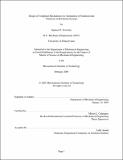Design of compliant mechanisms for attenuation of unidirectional vibrations in rotational systems
Author(s)
Szczesny, Spencer E., 1981-
DownloadFull printable version (29.34Mb)
Other Contributors
Massachusetts Institute of Technology. Dept. of Mechanical Engineering.
Advisor
Martin L. Culpepper.
Terms of use
Metadata
Show full item recordAbstract
The purpose of this research was to generate the knowledge required to design compliant mechanisms that (1) attenuate undesired small-motion angular vibrations in rotational power transmission systems and (2) preserve the desired transmission of large-motion torque/angle inputs. This thesis investigates the design of vibration attenuating compliant mechanisms that are directly integrated into the load path of rotational systems. These devices enable designers to attenuate the amplitude of undesirable vibrations while simultaneously optimizing the transmission of torque inputs. The design, modeling, fabrication and experimental validation of two Compliant Vibration Attenuator (CVA) concepts will be presented. The first device, the Small Amplitude Vibration Isolator (SAVI), is a non-linear compliant device that isolates a resonating or non-resonating rotational system from vibrations by acting as a mechanical lowpass filter. The second device, the Damping Vibration Link (DVL) utilizes compliance and damping to attenuate undesired vibrations due to resonance. A linear lumped parameter model was created in Matlab® to simulate the static and dynamic characteristics of rotational power transmission systems. This model enables one to determine the dynamic characteristics of a system for a given set of inputs, thereby making it possible to (1) understand the requirements for the CVA and (2) ascertain the effect of the CVA on the system. Finite-element simulations were conducted to verify an empirical, parametric model that describes the performance of a SAVI as a function of its stiffness parameters. (cont.) Proof-of-concept prototypes were tested to verify performance predictions and to determine the practical issues related to implementation. The thesis concludes with a case study which demonstrates the effectiveness of a SAVI when integrated into the steering system of a light-duty pickup truck. The SAVI was shown to offer a 60% reduction in vibration amplitude by trading off 7 ms of delay in steering wheel-vehicle response.
Description
Thesis (S.M.)--Massachusetts Institute of Technology, Dept. of Mechanical Engineering, 2005. This electronic version was submitted by the student author. The certified thesis is available in the Institute Archives and Special Collections. Includes bibliographical references (leaves 146-148).
Date issued
2005Department
Massachusetts Institute of Technology. Department of Mechanical EngineeringPublisher
Massachusetts Institute of Technology
Keywords
Mechanical Engineering.